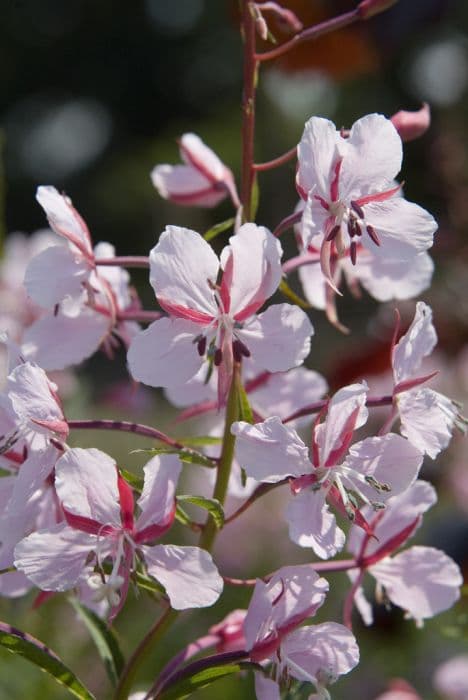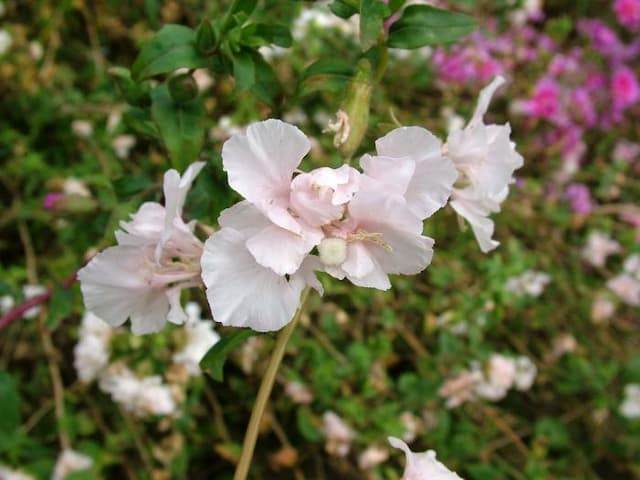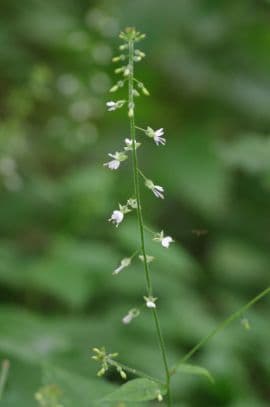Hardy Fuchsia Fuchsia 'Bernisser Hardy'

ABOUT
The Fuchsia 'Bernisser Hardy' is a captivating plant that is well-known for its unique and decorative flowers. These flowers are truly showy: they dangle from the branches like delicate ornaments, each composed of two contrasting colors. The outer parts of the petals, often referred to as sepals, are typically a graceful, long-lasting pink shade that curls backwards, exposing the softer inner petals which are usually a rich purple or sometimes a vivid violet. The blooms are characteristically teardrop-shaped, hanging from the plant in clusters, and are known for their exotic appearance that adds an elegant touch to any garden. The foliage of the 'Bernisser Hardy' adds a lush backdrop to the stunning flowers with deep green leaves that have a slightly glossy appearance, creating a perfect contrast. In addition to its flowers, this plant may produce small, oval-shaped fruit that is edible, though it's more often prized for its ornamental qualities. The overall form of 'Bernisser Hardy' is gracefully arching, giving it a soft, cascading appearance that is very appealing when the plant is in full bloom.
About this plant
 Names
NamesFamily
Onagraceae.
Synonyms
Lady's Eardrops, Hardy Fuchsia, Hummingbird Fuchsia, Bellflower.
Common names
Fuchsia 'Bernisser Hardy'.
 Toxicity
ToxicityTo humans
Fuchsia 'Bernisser Hardy', more commonly known just as Fuchsia, is generally considered non-toxic to humans. However, as with any plant, individual allergies or sensitivities can occur. Ingestion of significant amounts of plant material may cause mild gastrointestinal discomfort. This might include symptoms such as nausea, vomiting, or diarrhea. If symptoms persist or in the case of a severe reaction, it is important to consult a healthcare professional.
To pets
Fuchsia, commonly referred to without the specific cultivar 'Bernisser Hardy', is generally considered non-toxic to pets, including cats and dogs. While this plant is not known for being poisonous, ingestion of any plant material can potentially cause mild gastrointestinal upset in some pets. This would typically include symptoms like vomiting or diarrhea. If you observe any unusual symptoms or behaviors after your pet has ingested part of a Fuchsia plant, it is best to contact your veterinarian.
 Characteristics
CharacteristicsLife cycle
Perennials
Foliage type
Deciduous
Color of leaves
Green
Flower color
Mixed
Height
2 feet 4 inches (71 centimeters)
Spread
2 feet 4 inches (71 centimeters)
Plant type
Shrub
Hardiness zones
6
Native area
Central America
Benefits
 General Benefits
General Benefits- Attractive Flowers: Fuchsia 'Bernisser Hardy' has beautiful, pendulous flowers that add aesthetic appeal to gardens and landscapes.
- Hummingbird Attractor: The vibrant flowers are known to attract hummingbirds, providing natural beauty and pollination benefits.
- Long Blooming: This plant typically has a long blooming season, providing color and interest for an extended period.
- Versatile Gardening: Fuchsias can be grown in pots, hanging baskets, or in the ground, offering flexibility for gardeners with different space and design needs.
- Shade Tolerance: Fuchsia 'Bernisser Hardy' is particularly well-suited for shaded areas where other flowering plants might not thrive.
- Cool Climate Adaptation: It is suited to cooler climates and can be grown successfully in regions with mild summers.
- Deciduous Shrub: Fuchsia 'Bernisser Hardy' being a deciduous shrub can be pruned back in the dormant season, which helps to maintain its shape and promote vigorous growth.
 Medical Properties
Medical PropertiesThis plant is not used for medical purposes.
 Air-purifying Qualities
Air-purifying QualitiesThis plant is not specifically known for air purifying qualities.
 Other Uses
Other Uses- Fuchsia 'Bernisser Hardy' can be used as a natural dye for textiles, producing a range of colors from pink to purple depending on the mordant used.
- The berries of the fuchsia can be used in making jams, jellies, or pies, offering a tart flavor reminiscent of kiwi or passionfruit.
- Fuchsia flowers can serve as edible decorations for salads, desserts, and drinks, adding a splash of color and unique taste.
- These plants make excellent subjects for bonsai, allowing gardening enthusiasts to create miniature landscapes indoors.
- Fuchsia plants can be used in containers or hanging baskets to create living curtains or privacy screens on patios or balconies.
- Fuchsia cuttings can be rooted in water or damp soil, making a straightforward and educational project for children learning about plant propagation.
- Dried fuchsia flowers can be incorporated into potpourris, providing color and a light scent reminiscent of their fresh floral aroma.
- The plant can be utilized in butterfly gardens as the flowers attract hummingbirds and certain species of butterflies that feed on its nectar.
- Fuchsia flowers can be pressed and used in craft projects like making bookmarks, greeting cards, or decoupage art pieces.
- The wood from pruned fuchsia branches can be repurposed into small stakes for supporting other plants in the garden.
Interesting Facts
 Feng Shui
Feng ShuiThe Fuchsia is not used in Feng Shui practice.
 Zodiac Sign Compitability
Zodiac Sign CompitabilityThe Fuchsia is not used in astrology practice.
 Plant Symbolism
Plant Symbolism- Confiding Love: The fuchsia plant, which tends to have pendulous, bell-shaped flowers, symbolizes a deep and trusting emotional bond, especially in a romantic context.
- Elegance and Gracefulness: With its delicate and intricate blossoms, the fuchsia is often used to represent sophistication and a dignified beauty.
- Good Taste: The beauty and unique nature of fuchsia blooms can also signify a sense of excellent aesthetic judgment, or the presence of good taste in one's life.
- Amiability: The friendly appearance of the flowers, which look like they are gently nodding in agreement, can symbolize warmth and amiability in human relationships.
- Overflowing Abundance: Fuchsia plants can produce an abundant number of flowers, representing a wealth of love, kindness, and positive energy.
 Water
WaterTo properly water a Fuchsia, also commonly known as "Lady's Eardrops," it is important to maintain consistently moist soil without waterlogging the plant. They prefer a humid environment and a watering schedule that ensures the top inch of soil remains damp. Typically, Lady's Eardrops should be watered approximately once or twice a week, depending on the climate and the indoor environment. During active growth in spring and summer, they may need about 1 to 2 gallons of water every week, but be sure to reduce watering in the winter when the plant is not actively growing. Always allow the excess water to drain away to prevent root rot, which can be deadly for these plants.
 Light
LightLady's Eardrops thrive in bright, indirect light, which makes them ideal for a spot that receives morning sunlight and afternoon shade. Avoid placing them in direct midday sun, which can scorch their delicate foliage and flowers. An eastern or northern exposure window would be an optimal location to provide the right balance of light without the harshness of the afternoon sun.
 Temperature
TemperatureLady's Eardrops prefer a temperature range that reflects their native tropical to subtropical habitats, generally between 55 and 75 degrees Fahrenheit. They can tolerate a minimum temperature down to about 50 degrees Fahrenheit, but they are not frost-tolerant and should not be exposed to temperatures below this threshold. The ideal growing conditions would be a consistently warm, draft-free environment that maintains a temperature within their preferred range.
 Pruning
PruningPruning Lady's Eardrops is essential to promote bushy growth and prolific blooms. Prune the tips of the branches in early spring to encourage branching, which results in more flowers. Additionally, remove any dead or diseased wood as needed to maintain plant health and appearance. The best time for major pruning is late winter or early spring, just before the new growth begins.
 Cleaning
CleaningAs needed
 Soil
SoilFuchsia 'Bernisser Hardy', commonly known as Hardy Fuchsia, thrives best in moist, well-draining soil with a pH between 6 and 7. A premium potting mix with added perlite or vermiculite and compost is ideal to promote health and blooming.
 Repotting
RepottingHardy Fuchsia should be repotted every two to three years to refresh the soil and accommodate root growth. It's best to repot in spring, just before the growing season begins.
 Humidity & Misting
Humidity & MistingHardy Fuchsia prefers high humidity levels, typically around 60-70%. To maintain these conditions, especially when grown indoors, regular misting or a humidity tray may be beneficial.
 Suitable locations
Suitable locationsIndoor
Place Hardy Fuchsias where they get bright, indirect light and keep moist.
Outdoor
Plant in partial shade, sheltered from wind, with moist, well-draining soil.
Hardiness zone
6-9 USDA
 Life cycle
Life cycleThe Fuchsia 'Bernisser Hardy', commonly known as Hardy Fuchsia, starts its life as a seed, which germinates in moist and warm conditions to produce a small seedling. As it grows, the plant enters its vegetative stage, developing stems, leaves, and a root system. During spring and summer, the Hardy Fuchsia transitions to the flowering stage, where it produces distinctive dangling blooms in shades of pink, purple, and white that attract pollinators. After pollination, the flowers develop into small fruit containing seeds for the next generation. In preparation for winter in colder climates, this perennial plant undergoes dormancy, where growth slows down, and it may die back to the ground to conserve energy. The following spring, the Fuchsia 'Bernisser Hardy' regrows from its root system, repeating its life cycle.
 Propogation
PropogationPropogation time
Spring-Summer
The popular method for propagating Fuchsia 'Bernisser Hardy' is through softwood cuttings. This technique is generally employed during spring or early summer when new growth is green and flexible. To start the process, a gardener should select a healthy shoot and cut a 3 to 5-inch (approximately 7.5 to 12.5 cm) length just below a leaf joint. The lower leaves are removed and the cutting is dipped in rooting hormone to enhance root development. The prepared cutting is then planted in a pot filled with a mixture of peat and perlite or a similar well-draining medium, and kept under high humidity and indirect light. With consistent moisture and warmth, roots will typically form within a few weeks, after which it can be gradually acclimatized to less controlled conditions.









